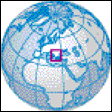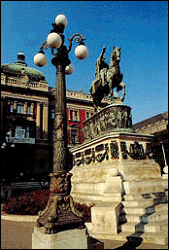 FACTS FOR TRAVELLERS FACTS FOR TRAVELLERS |
see map
Official name: The Republic of Serbia and the Republic of Montenegro are the constituents of the Federal Republic of Yugoslavia.
Area:
88,361 sq. km
Geographical location: Serbia is in the central part of the Balkan territory in the South - Eastern part of Europe.
The length of Serbia's border is 2,397 km. To the East Serbia borders with Bulgaria, to the North East with Romania, to the North with Hungary, to the West with Croatia and Bosnia and Herzegovina, and to the South with The Republic of Montenegro, Albania and Macedonia.

Climate: Temperate continental climate with warm summers and snowy winters.
Population: Approx. 10 million (Statistics 2002). Serbia excluding Kosovo and Vojvodina, 5,753,825.
Capital: Belgrade, with some 2 million inhabitants.

Language: The official language is Serbian. Members of national minorities are entitled to use their own languages.
Religion:
Serbian Orthodox is the prevailing religion. Other religions may be freely practiced.
Time: GMT + 1
Currency: Dinar (YUD) - 1 = 100 paras
Coins: 5, 10, 20, 50 paras, 1, 2 and 5 dinars
Banknotes: 5, 10, 20, 50, 100, 200 and 1000 dinar notes
Banks & post offices: Office hours, on workdays: 08.00 - 19.00; on Saturdays: 08.00 - 15.00. In Belgrade and other larger cities in Serbia, some banks and post offices are open even on Sundays.
Stores: Supermarkets and other food selling stores are open from 06.00 to 20.00. Other stores are open from 08.00 to 20.00. On Sundays, they are closed. Everywhere, there are stores open 24 hours.
Power supply voltage: 220 V
Area codes: For Yugoslavia 00381, for Belgrade (0)11, for Novi Sad (0)21, for Pristina (0)38.
To call from Yugoslavia: dial 99 + the code of the desired country + the code for the city.
 Visas, Embassies & Border Crossings Visas, Embassies & Border Crossings |
To enter Yugoslavia with your own car it is compulsory to pay an additional insurance of about 78,50 EURO. The foreigners have to exclusively pay the tolls of the highways in foreign currency and they cannot pay in local currency (dinar).
| Slovenian citizens need a valid passport with visa to enter Serbia (a part of Federal Republic of Yugoslavia), a passport (without a visa) to enter Kosovo and only an ID to enter Montenegro. Theoretically you can stay in Serbia without any visa.
However, for Australians, at the moment the price of an entry visa into Yugoslavia costs A$50.
 Travel Tips Travel Tips |
Kosovo: Don't be put off by the reputation of the place. In general it's a friendly, open area in which to travel. Do, however exercise some commonsense and keep in mind what the country has been through. In some parts of the country the water is safe to drink in some parts it's not. The best bet is to stick to bottled water.
Zagori is a good brand that is plain and available almost everywhere. Shoes should be removed before entering all homes in Kosovo. The piles of shoes outside the door to should be a helpful reminder. It's considered terribly impolite to neglect this bit of common courtesy. The locals are friendly and for the most part travelers should not feel threatened, although Westerners are likely to have a hard time being innocuous outside of Pristina's UN area.
If you've gone all the way to Kosovo only to end up in Pristina or Prizren, it's worth a trip to one of the hundreds of tiny villages that pepper the countryside. In any town there are kimbis (vans) going to villages at any hour of the day. Unless you have a death wish avoid local beers. Do, however try rakija if you get the chance. But be careful - most of it is homemade. Come with cash. There's not an ATM to be found anywhere in Kosovo yet. Be aware that both electricity and water are subject to be terminated without notice for an indeterminate length of time, no matter where you are.
When on Yugoslavian territory, don't ever forget to report to the local police station within 24 hours of your arrival. It is very easy to do and can actually save you from lots of bad things that might happen to you while trying to leave the country. That is especially true for travellers taking trains and buses. Even the most pleasant Serbian will not be able to save you from terrible questioning at the border if you're found not to have reported your stay with the local police.
Almost all the hotel prices have roughly doubled in price. The bank exchange rate for Serbian dinars is extremely poor and one could get a much better exchange rate from one of the many private exchange offices. They change all other major currencies at similar rates. All banks refuse to change Serbian dinars to foreign currencies, but this could be achieved at the private exchanges at roughly the same rate.
Due to the UN sanctions (especially after the Kosovo war), credit cards are no longer accepted in any banks or shops in Yugoslavia. Hardly any banks accept travellers cheques either, for the same reason. For the few banks that do accept travellers cheques, you can only cash them for Serbian dinars, which they would give using a poor bank exchange rate. It is therefore highly advisable to have hard cash (DM gives the best exchange rate) with you before entering into Yugoslavia. In Belgrade however, we found a tiny branch of Beobank which is perhaps the last place that gives you foreign currency for your travellers cheques. It is located close to the Australian embassy on the ground floor, but you would be directed first to the 6th floor of another building to get the paper work done before returning to get the cash.
Due to NATO bombing, many of the bridges serving the rail have been destroyed. Though in some cities replacement bridges have been built, they looked pretty temporary and do not seem to accommodate rail lines. Hence, trains to Novi Sad are no longer available from cities south of Novi Sad. A common solution is to get off the train at Belgrade, change for a bus to Novi Sad and continue the rail journey. On the other hand, the bus network in Serbia is quite extensive and might be preferred over the rail which costs more anyway.
You can freely visit the places which were being bombed by NATO during the 77 day siege. Ask around and the locals will be more than willing to guide you to these sites of destruction. At the tourist information centre in Belgrade, they have produced an attractive colour brochure depicting the before/after bombings of various installations in Belgrade and their whereabouts.
|

